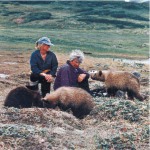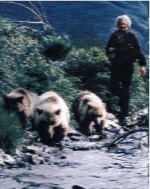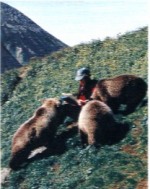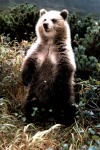Cub Reintroduction
Exit With Cubs From Petropavlovsk

The director of the Petropavlovsk Zoo made it very clear to us May 25, 1997 that there was a death sentence on the heads of 3 grizzly cubs which had been brought to him earlier in the month when a hunter had, by accident, killed their mother. The first time we saw them they won our hearts. The Zoo had no money to feed them and Zoo visitors were throwing food in to them as they played behind the iron bars. We had a carrying box built for their transport that night.
It was May 28th - the helicopter was loaded with a 6 month supply of food and supplies. Charlie was converting his plane to floats while Maureen picked up the cubs from the Zoo. Just as the helicopter was to leave, Tatyana Gordienko showed up representing the Nature Conservation department to do an inspection of our cabin, which we had built the year previously. Maureen kept her outside the chopper until the engines started up as she did not want her to hear the cub noises coming from the rear end of the cargo area. Finally, we were all in the air heading south.
Our permissions for initiating a cub re introduction program had not been finalized on paper - only verbally approved. When Tatyana got out of the plane at our cabin site, she said we were crazy, but indicated she liked crazy people! She helped us a lot in the months that followed as many officials came and went, threatening all kinds of repercussions for our lack of paper-work.
Living With The Cubs
One of the items unloaded from the helicopter on May 28th was enough lumber to build a cub house and we had to construct it on 8 feet of snow! They lived in the cramped conditions of their cub carrying box for the first 3 days. They were ecstatic at the new freedom of the cub house and even more so when we first let them out to take them for walks. We started right away to blow a whistle when we placed food out for them in the hopes that if we were separated during a walk, that they would come to the whistle. Chico led the pack as they tore off over the snow those first few walks. We were terrified as they dis appeared from sight. The whistle worked as they quickly learned it meant not only food but our presence.
During June we cooked porridge and put it into their rubber bowls, along with milk and some sunflower seeds. We did not once hand feed them. As time went on we switched to providing only the dried sunflower seeds and when the char returned - up to 12 fish per day between them. We learned that feeding them twice a day was enough if we provided just a bit less than they could eat. Their diet must have been good as by September they were almost twice the size of their wild cousins and more confident young bears, as a result of being larger.
When the snow finally melted we enclosed about 2 acres with (solar powered) electric fence around the bear's house. This was adjacent to our cabin. We could hear their every movement and the chirring of Rosie. She had the equivalent of a thumb-sucking problem and sucked on Biscuit's hair. This sound was eerie and haunting. We would awaken at night hearing it. The names we gave the bears were Chico, Biscuit and Rosie. They were our family and each cub had distinct personalities.

Chico was the leader. Biscuit the gentle "Mother" and Rosie the artist. Rosie always lagged behind exploring every detail of the world. All three shared their absolute joy of life which was contagious and overflowed into ours.
Initially the cubs were about 14 pounds but had reached nearly 200 pounds by denning. Coincidental with the increase in size came an increased desire for independence. They quickly learned to eat wild plants and later pine nuts on their own. We did teach them to fish though. Mothers in the wild fish for their cubs, often until they are 3 years old. We felt we had to give them a boost for their survival in the untamed environment and so helped them with their fishing skills. We dumped some pieces of dead and live char in a small stream where they would have a chance of catching one. We showed them once that fish were in there and they were on to it! Unfortunately, every creek hence-forth did not contain the same bounty. By September they were catching spawning salmon in the lake.
We could not get enough of their spirit. It was like an opiate. The thought of something happening to them was unbearable and when we finally agreed that it was time to open their pen to let them go out on their own, it was difficult. The first time they did not come home overnight in September made us feel like we had our teenage daughters out there on their first dates. We lay awake all night imagining the worst. When they did return the next day, we followed their tracks in the dew back to where they had spent the night. Merely more love of life and freedom and independence and a nice night out under the alders!
The cubs were inseparable and it was not long before they demonstrated the same concern for us if we were upset as they did for one another. When we took responsibility for the well-being of three incredible young, intelligent grizzly cubs we did not know what we were in for. Very soon we, who were their saviours, found ourselves the privileged ones just by being in their company. With their clear demonstration of joy when we were with them, they seemed to invite us to share their lives. We found them highly intelligent and emotionally responsive animals.
Our Role As Protectors

There is a lot of documentation and speculation about male bears killing cubs and eating them. This possibility was considered by all the "bear experts" in Petropavlovsk as the number one danger we would face in our effort to re introduce our 3 cubs back into the wild. They even went so far as to suggest that our activity would be a wasted effort.
We consequently worried about adult bears attacking our cubs, especially when we found a bear scat with the claws of a very young cub in it. But our cubs seemed to somehow know to be fearful of other bears and it was common for us to run into bears while with them at close range. The cubs would often run by us in their haste to get away. They seemed to hesitate for us to join them but only momentarily, we were soon far behind.
On more than one occasion we lost them for hours after such encounters. It took all our bush skills to track them. They were in the middle of a pine thicket once. Another time high up on a hill. On one occasion Maureen found them watching a wild bear wandering by below which she had almost run into. The cubs demonstrated concern for her when she was so close to the wild bear with much chuffing. She wasn't sure who was looking out for whom.
Other dangers existed. Once Chico fell through some ice with running water under it and held on to the edge with her claws until Maureen plucked her out. Another occasion, Biscuit climbed far up a cliff and was afraid to come down until Charlie crawled up with her. When they first started sliding down the steep snow field, they would slam into rocks at high speeds until they learned the rolling onto all fours self- arrest technique! We soon had more grey hair.
By October their panic over meeting other bears lessened. Their care with mountain climbing increased until familiarity with the country and their ability to move through it safely was flawless. The wild bears seemed to respect their presence and gave them some claim to the area around our cabin. We began to worry less as they stayed away for days at a time foraging on berries, pine nuts and salmon.
Return to Kambalnoe Lake for Denning

We wanted to monitor the denning of our cubs to be sure they were safe. When I, Charlie, returned to Kambalnoe Lake on October 28, 1997, Bill and Tip Leacock and their two daughters (who had stayed in camp during our absence) reported that the cubs were doing well but acting rather lethargic.
When it snowed for the first time on November 1st, the cubs stayed away from the cabin for two and a half days, but were back again when it warmed up. In addition to salmon and pine nuts they found for themselves, I was still providing some sun flower seeds for their consumption when they returned to the cabin. Maureen and I had worried that if we did not stop this provision, the continuously provided food supply might dangerously delay their denning. I had decided to stop feeding on November 12th. As it turned out, I did not have to do this. On November 6th, the snow storm hit that started the denning process. On the morning of the 7th, they came in for sun flower seeds and left to spend the day on the east slope in sight of the cabin. They moved higher and soon were in the Northeast Basin at about 2000 feet. I walked up Char Creek to a place where I could watch the whole basin and spotted them high on the ridge. The last I saw of them, they were in some alder slowly working their way up even higher. They were doing some digging in the snow and some playing, looking happy even though it was - 5 degrees Celsius with drifting snow.
The next day I walked to the same look-out and could only see their tracks in the snow going over the ridge to the pine bush and alder I knew were just over the top. I did not want to hike to this location in fear of disturbing the denning site by being there. I know bears to be very sensitive about their denning locations and will relocate if disturbed.
Over the next few days I watched 9 other bears, including mothers and cubs, digging their dens. Some were bears I had recently seen fishing in the lake. The lake froze November 9th. Their timing was right on! Our cubs knew what they were doing.
Delayed Return To Canada
I, Charlie, was booked on an Air Alaska flight to Calgary on December 1st, having made arrangements to be picked up at Kambalnoe Lake between the 20th and 26th of November. There was lots to observe even after our cubs had denned up. Stellar Sea eagles, the largest eagles in the world, had accumulated for the last salmon before freeze-up and I spent time with one of the eagles that had a damaged wing. A fox befriended me to help fill the vacuum left by the cubs. As November wore on I started to realize that there were very few days when a helicopter could fly in to get me. The wind was high and big drifts of snow built up right inside the cabin, having come in under the door. East winds brought snow in on my bed through tiny holes in the eaves. November 26 was soon history and my flight date home came and went. On December 3 a calm night finally lingered into morning and I packed up quickly and sealed up the door and windows. The helicopter arrived just as another storm hit from the south. My preparations for a quick departure paid off as the pilot had to take off in zero visibility as it was. The chopper was quickly coated in ice - it was the scariest flight I have ever made. The last weeks in camp were frugal food-wise as I was down to only three boring things that I could eat. Landing in Petropavlovsk was welcomed!
Maureen had rebooked a flight on the 8th of December and I almost did not make it on that one either due to a mix-up with my visa registration. Tatyana Gordienko called the Governor of Kamchatka 15 minutes before flight time which did the trick with local immigration officials allowing me to climb aboard at the last minute.
"The last I saw of them, they were in some alder slowly working their way up even higher."
Electric Fence For Kurilskoye Lake Science Station
We are testing some of our theories about the value of using electric fencing in bear country at the Science Station at Kurilskoye Lake. It is our hope that the 20 researchers who live there can do so in greater harmony with the many brown bears who come to the lake during the salmon run.
Bill Leacock and I built a solar powered electric fence around the ten acre compound. Their children can now play safely close to the fence as bears wander by which certainly causes their parents to relax. A lot of attention was paid towards the construction of the fence and it's location, so that it would not interfere with the normal patterns of movements of the bears. No bears got into their fish weir this year nor into their garbage or gardens.
This is likely one of the best examples in the world of how a group of people who previously lived in conflict with the grizzlies, now live in harmony and all due to the simple installation of an electric fence!
